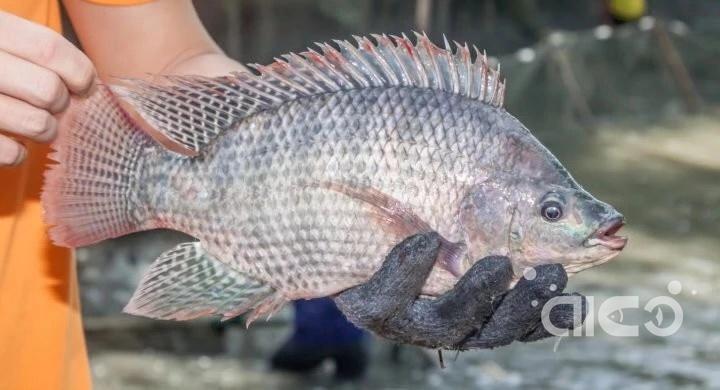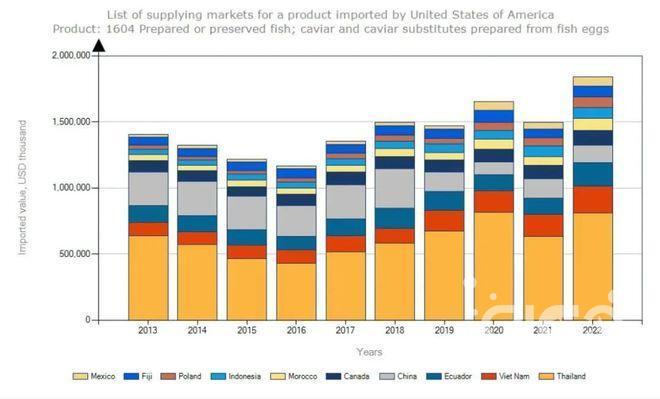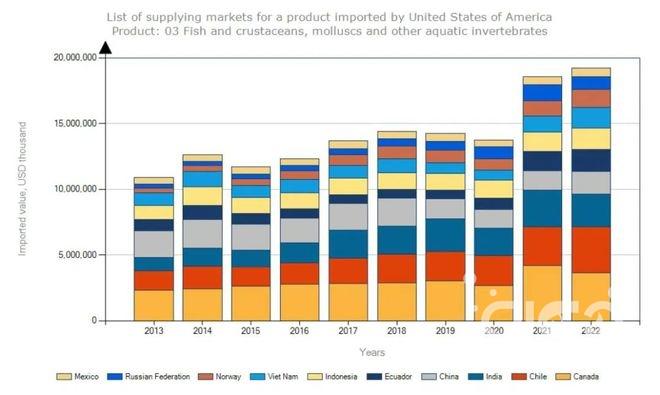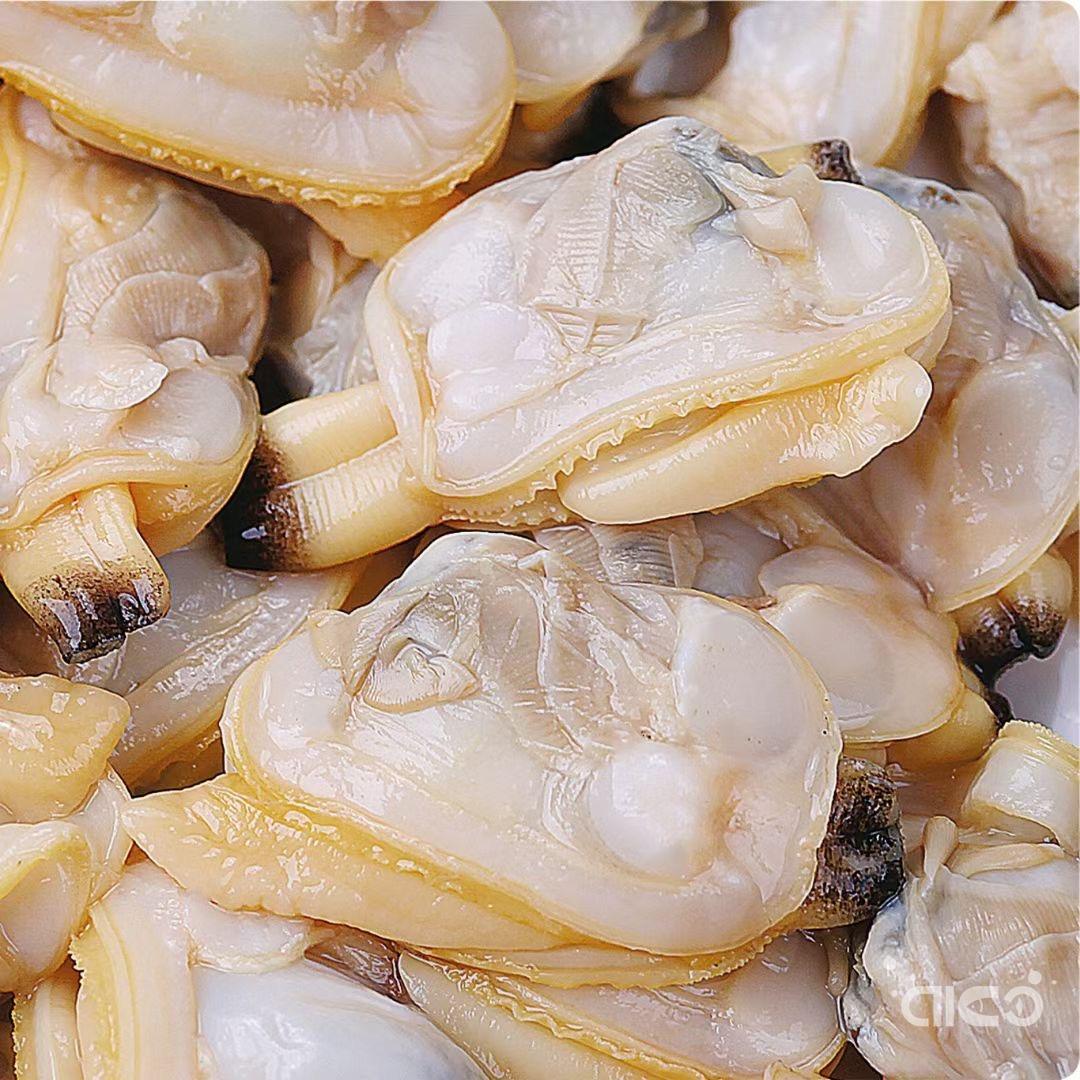China's seafood exports in 2023: three major categories declining & two major factors contributing
The situation is not optimistic as the export value of all three categories decreased
Firstly, according to the latest statistics from Marketing, China's export value of primary aquatic products (03 items) in the first half of 2023 amounted to US$5.16 billion, down 20.0% from US$6.19 billion in the same period last year. Among them, the export value of five major exporting provinces, including Shandong and Fujian, subtotaled to US$4.73 billion, down 21.4% from US$5.75 billion in the same period last year. Considering that the global epidemic has passed and production and logistics have returned to normal, such a drastic decline is very rare.
In terms of exports of deep-processed aquatic products, exports of deep-processed fish (item 1604) in the first half of 2023 amounted to US$2.02 billion, down 22.1% from US$2.47 billion in the same period last year; exports of deep-processed shrimp, crab, shellfish and squid (item 1605) amounted to US$2.60 billion, down 4.5% from US$2.72 billion in the same period last year. It can be said that in the three categories, deep-processed shrimp, crab, shellfish and squid performance is relatively good.
Overall, the value of aquatic exports of the three major categories declined in the first half of the year, only to varying degrees. Deep-processed fish had the largest decline, primary aquatic products accounted for the largest proportion of exports, while the decline in deep-processed shrimp, crab, shellfish and squid was the smallest. Such a situation is not optimistic for the aquatic export situation.

Decrease in total exports, down as much as 16.3% in the first half of the year
The total exports of the three types of aquatic products showed 9.78 billion U.S. dollars in the first half of 2023, and the total exports in the first half of 2022 was 11.37 billion U.S. dollars, a year-on-year drop of up to 16.3%. 5.26 billion U.S. dollars in the first half of 2023, the total exports of the five major export provinces, a year-on-year drop of 8.5% in the first half of last year, which shows that the five provinces have a higher ability of resisting risks than the other provinces. The situation is even less optimistic for other provinces as their export value dropped even more.
Primary aquatic exports: Fujian plummets, Liaoning's wild ride is remarkable. In the first half of 2023, the export situation of primary aquatic products was not optimistic. Shandong, Fujian and Zhejiang all suffered a decline, with exports from Fujian down 64.7%, Shandong down 21.7% and Zhejiang down 10%. Only Liaoning's exports grew by 23.9% and Guangdong's by 2.5%.
The reasons for this are complex. We believe that one of the reasons for the significant decrease in Fujian and the increase in Liaoning is that during the epidemic last year, orders were temporarily transferred to fish processing plants in Fujian as many of them were closed. However, processing plants in Liaoning resumed production in the first half of this year, and those orders came back to Liaoning. At the same time, the import, procurement and transportation of raw materials shifted as well. As a result, Fujian's exports fell by 64.7 percent in the first half of the year, not just because of the shift in orders from Liaoning, but also because of the overall decline in foreign orders in the first half of the year.
Deep-processed fish exports: Guangdong down sharply, Liaoning strong growth
In terms of further processed fish exports, the situation is similar to that of primary fish exports. 2023 H1, Fujian, Hainan, Shandong and Guangdong all suffered a recession, with Guangdong's export value falling by 58.1%, Hainan's by 55.4%, Fujian's by 13.9% and Shandong's by 10.7%. Only Liaoning export value growth of 19.9%, Zhejiang slightly decreased by 0.2%.
Guangdong, Hainan are tilapia, golden pomfret export province, most of these products are exported to the U.S. market. In 2023, when Sino-U.S. relations are increasingly tense, it is not surprising that exports of these products to the U.S. have decreased significantly. In addition, the United States in 2023, high domestic inflation, seafood imports gradually reduced, but also affect the tilapia fillets, golden pomfret fillets and other products imported. Liaoning export growth is also due to many processing plants closed last year, this year, the resumption of production brought about by the "compensation effect", not the market exceptionally favored Liaoning. Therefore, remind Liaoning's export enterprises must not be blindly optimistic.

Exports of deep-processed shrimps, crabs, shellfish and squids: relatively good situation, almost no attenuation
In terms of exports of deep-processed shrimp, crab, shellfish and squid, only Guangdong's export value decreased by 32.7% in the first half of 2023, while the other major exporting provinces were basically fine. Shandong even grew by 6.7%, Liaoning and Zhejiang also increased slightly, while Fujian saw a small decrease in export value.
Guangdong's exports have slipped significantly may be due to the headless shrimp, headless shrimp, breaded shrimp exports decreased, these products are mainly exported to the United States. Competition among countries is already exceptionally fierce, coupled with the fact that U.S. shrimp imports decreased year-on-year for many consecutive months in 2023, leading to a substantial decrease in Guangdong's exports of shrimp products to the U.S. and other countries.
The steady rise in exports from other major exporting provinces indicates that the products from these provinces are not the categories with the most serious market decline in the first half of this year, but rather belong to the niche boutique category, or non-U.S. demand, or new products on the market. It is these products that have the greatest potential in the international market.

Hyperinflation and trade wars: two reasons for China's declining fish exports
In theory, this is the first year after the epidemic, production and logistics are recovering, and China's aquatic exports should have been thriving in the first half of 2023. However, we believe that the dismal export situation in the first half of this year is mainly due to two reasons.
1. Weak consumption across countries due to high inflation.
Since the Federal Reserve began to raise interest rates in the second half of 2022, the U.S. Treasury rate has gradually risen, especially with the continued rate hikes in the first half of 2023, and the general trend of interest rate hikes globally. This has led to a general increase in prices, with factors such as trade wars contributing to the increase. Retail prices of seafood have risen more significantly relative to other food items. As seafood is not an essential food but an optional one, the demand for and import of seafood in various countries have gradually declined. Consumers are more inclined to spend their limited funds on daily necessities rather than buying seafood products.
We can compare the monthly seafood imports of major countries in recent months: since January 2023, the year-on-year monthly imports of major seafood importers such as the U.S., Japan, and Spain have begun to decline; by April 2023, the year-on-year monthly imports of more major seafood importers have declined, including the U.S., Japan, Spain, South Korea, France, and the U.K., among others. As more and more of the major seafood importing countries' markets begin to shrink, the picture for global seafood exports is expected to be bleak in 2023, a trend that could continue through the end of the year and beyond.
This global market downturn is certainly not just affecting the seafood and food industry, but is rippling through all sectors. Therefore, the main reason for the significant decline in Chinese seafood exports in the first half of 2023 is the weak consumption in various countries due to high inflation.


2. The trade war has led to a shrinking market for Chinese exports to the United States.
The U.S., as the world's largest importer of seafood, has in the past had China as one of its major suppliers of seafood. Many U.S. fish (e.g., Alaskan pollock, Pacific salmon, various flounders, red snapper, etc.) are also processed in China and then returned to the United States.
This is clear from the chart below: until 2018, China had been one of the top seafood suppliers to the U.S. across product categories including 0300, 1604, and 1605. however, since the start of the U.S.-China trade war in the second half of 2018, the U.S. has seen a gradual decline in seafood imports from China and a gradual shift to neighboring countries such as Canada, Chile, and Ecuador, as well as India, Vietnam, Indonesia and other Asian countries. We expect the volume and variety of seafood imported by the United States from China to further decrease in the future. Although Chinese companies have also made efforts to enter the U.S. market through third countries in recent years, such as Malaysia and Mexico, these methods are not convenient enough and costly.
As the U.S. dependence on China further diminishes, the U.S. may import fewer and fewer aquatic products from China in the future. Those Chinese aquatic export enterprises that are highly dependent on the U.S. market should make early adjustments.







